Financial accounting table of contents inTRODUCTION 1
39 Pages5192 Words104 Views
Added on 2020-10-23
About This Document
This accounting system supports entities in identifying the financial health of company and making necessary modifications in practices so that profit of organization can be increased (Beatty and Liao, 2014). Financial accounting can be defined as a specialized branch of accounting that emphasises more on providing necessary details to investors or external stakeholders so that their interest can be enhanced (Brewer, 2013). Financial accounting can be defined as a specialized branch of accounting that emphasises more on providing necessary details to investors or external stakeholders so that their interest can be enhanced (
Financial accounting table of contents inTRODUCTION 1
Added on 2020-10-23
ShareRelated Documents
FINANCIAL ACCOUNTING

TABLE OF CONTENTS
INTRODUCTION...........................................................................................................................1
TASK 1............................................................................................................................................1
1. Financial accounting...........................................................................................................1
2. Regulations related to financial accounting.......................................................................3
3. Accounting rules and principles.........................................................................................4
4. Convention and concepts related to consistency and material disclosure..........................5
CLIENT 1........................................................................................................................................5
1. Drafting journals.................................................................................................................5
2. Double entry recording within relevant ledgers.................................................................8
..........................................................................................................................................................9
3. Trial balance to check arithmetical accuracy of double entry system..............................17
CLIENT 2......................................................................................................................................18
A. Profit and loss statement..................................................................................................18
B. Balance sheet...................................................................................................................18
CLIENT 3......................................................................................................................................20
A. Profit and loss statement of Raintree LTD......................................................................20
B. Financial position of Raintree LTD.................................................................................21
C. Accounting principles......................................................................................................26
Significance of measuring depreciation...............................................................................27
CLIENT 4......................................................................................................................................28
A. Purpose for framing bank statement................................................................................28
B. Rationale for recording in bank statements.....................................................................29
C. Client's cash book............................................................................................................29
CLIENT 5......................................................................................................................................30
A. Formation of sales ledger control account and purchase ledger control account............30
B. Control account................................................................................................................31
CLIENT 6......................................................................................................................................31
A. Suspense account and its characteristics.........................................................................31
B. Preparing trial balance.....................................................................................................32
C. Journals entries................................................................................................................33
INTRODUCTION...........................................................................................................................1
TASK 1............................................................................................................................................1
1. Financial accounting...........................................................................................................1
2. Regulations related to financial accounting.......................................................................3
3. Accounting rules and principles.........................................................................................4
4. Convention and concepts related to consistency and material disclosure..........................5
CLIENT 1........................................................................................................................................5
1. Drafting journals.................................................................................................................5
2. Double entry recording within relevant ledgers.................................................................8
..........................................................................................................................................................9
3. Trial balance to check arithmetical accuracy of double entry system..............................17
CLIENT 2......................................................................................................................................18
A. Profit and loss statement..................................................................................................18
B. Balance sheet...................................................................................................................18
CLIENT 3......................................................................................................................................20
A. Profit and loss statement of Raintree LTD......................................................................20
B. Financial position of Raintree LTD.................................................................................21
C. Accounting principles......................................................................................................26
Significance of measuring depreciation...............................................................................27
CLIENT 4......................................................................................................................................28
A. Purpose for framing bank statement................................................................................28
B. Rationale for recording in bank statements.....................................................................29
C. Client's cash book............................................................................................................29
CLIENT 5......................................................................................................................................30
A. Formation of sales ledger control account and purchase ledger control account............30
B. Control account................................................................................................................31
CLIENT 6......................................................................................................................................31
A. Suspense account and its characteristics.........................................................................31
B. Preparing trial balance.....................................................................................................32
C. Journals entries................................................................................................................33
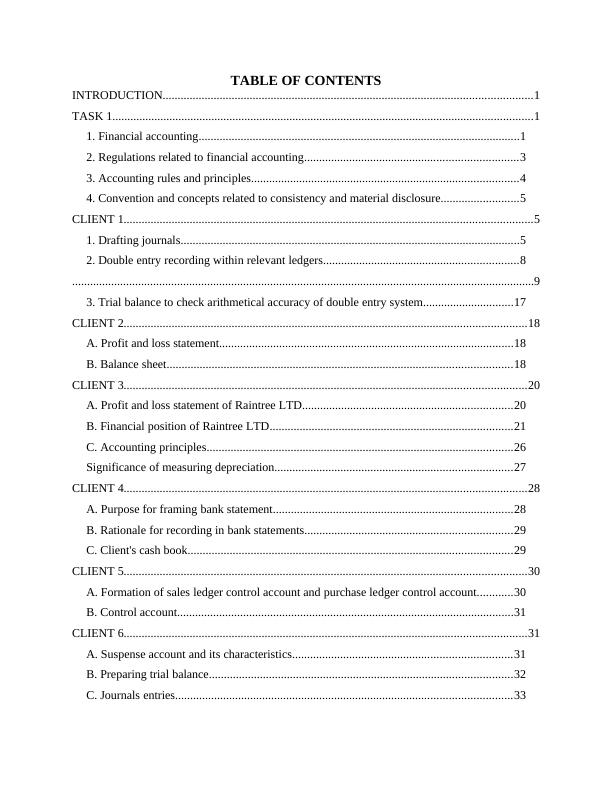
D. Difference between suspense account and clearing account...........................................34
CONCLUSION..............................................................................................................................35
REFERENCES..............................................................................................................................36
CONCLUSION..............................................................................................................................35
REFERENCES..............................................................................................................................36
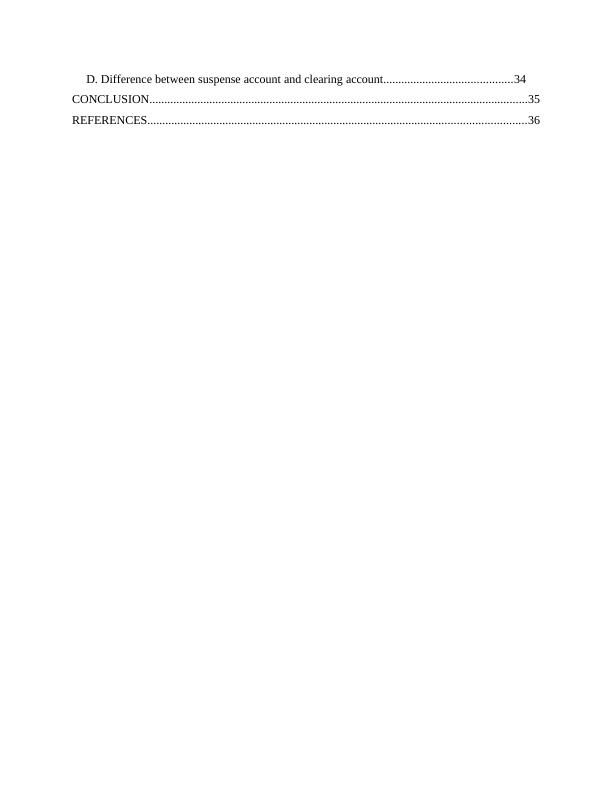
INTRODUCTION
Financial accounting (FA) is an essential part of business that assists in keeping track of
financial transactions. This accounting system supports entities in identifying the financial health
of company and making necessary modifications in practices so that profit of organization can be
increased (Beatty and Liao, 2014). This accounting process aids in providing necessary details to
investors and creditors that assist them in making correct decision of investment. Accounting
principles are set rules and regulations that help in analysing the funds and finding out actual
performance of enterprise. Present study will describe the regulations related to financial
accounting. Furthermore, it will explain the convention and concepts related to consistency and
material disclosure. Study will illustrate the bank reconciliation statement and sales purchase
ledger.
TASK 1
A.
To: Line Manager
From: Junior accountant
Subject: To explain the concept of financial accounting and its regulations
Respected Sir/Ma'am.
It is very important to have good knowledge about financial accounting regulations so
that transactions can be tracked and maintained in a proper manner. Company has to take support
of various techniques in order to perform the budgeting and forecasting activities.
1. Financial accounting
Financial accounting can be defined as a specialized branch of accounting that
emphasises more on providing necessary details to investors or external stakeholders so that their
interest can be enhanced (Brewer, 2013). Each firm has to use standardized guidelines in order to
maintain records and prepare financial reports. It is very important for company to prepare
financial statements as per given guidelines. Each firm has to prepare balance sheet, P&L, cash
flow and statement of stakeholder equity in an appropriate manner. All these records support in
providing necessary details to investors and creditors so that they can make their decision (Pratt,
2016).
1
Financial accounting (FA) is an essential part of business that assists in keeping track of
financial transactions. This accounting system supports entities in identifying the financial health
of company and making necessary modifications in practices so that profit of organization can be
increased (Beatty and Liao, 2014). This accounting process aids in providing necessary details to
investors and creditors that assist them in making correct decision of investment. Accounting
principles are set rules and regulations that help in analysing the funds and finding out actual
performance of enterprise. Present study will describe the regulations related to financial
accounting. Furthermore, it will explain the convention and concepts related to consistency and
material disclosure. Study will illustrate the bank reconciliation statement and sales purchase
ledger.
TASK 1
A.
To: Line Manager
From: Junior accountant
Subject: To explain the concept of financial accounting and its regulations
Respected Sir/Ma'am.
It is very important to have good knowledge about financial accounting regulations so
that transactions can be tracked and maintained in a proper manner. Company has to take support
of various techniques in order to perform the budgeting and forecasting activities.
1. Financial accounting
Financial accounting can be defined as a specialized branch of accounting that
emphasises more on providing necessary details to investors or external stakeholders so that their
interest can be enhanced (Brewer, 2013). Each firm has to use standardized guidelines in order to
maintain records and prepare financial reports. It is very important for company to prepare
financial statements as per given guidelines. Each firm has to prepare balance sheet, P&L, cash
flow and statement of stakeholder equity in an appropriate manner. All these records support in
providing necessary details to investors and creditors so that they can make their decision (Pratt,
2016).
1

Organization inputs and outputs considered statements with the help of evaluating
financial statement, financial accounting defines organization condition in market with the help
of financial statements, profit and loss statements, revenue and expenses. Financial accounting
reports decided what are corrective ideas to expand organization business with the help of
equations. Financial statements or equation are majorly corrective on the bases of organization
market structure. Financial accounting is based on organization business activity. Financial
accounting gathers summarizes organization equation and evaluated all the doubtful correction
and particular equation of variable sequence by the organization effects.
Financial accounting (FA) is the system that treats money for measuring economic
performance of entity. It keeps record of cash inflow and outflow in a systematic manner so that
financial statements can be prepared properly without any mistake. Generally accepted
accounting principles (GAAP) and International financial reporting standards (IFRS) are
considered as standard framework that describe principle to prepare the records (Scott, 2015).
The main objective of implementing financial accounting system is to provide necessary
information related to business health to outside stakeholders. Its purpose is to serve
requirements of equity investors. With the help of FA, company can analyse its economic
position, performance and can compare it with competitors. This financial accounting system
allows management in monitoring day to day transactions and analysing effects of these
activities on business health (Thornton, 2018). This supports creditors in identifying
creditworthiness of company so that they can make their decision of investing their money in
firm.
One of the main agendas of enterprises of using financial accounting principles is to
maintain capital so that they can utilize their financial resources properly and minimize cost as
well. Relevance, reliability, compatibility and consistency are the main aspects of FA. Company
always need funds so that it can run operations smoothly and can expand business. By looking at
financial records of business, investors get necessary details about company. This aids them in
making their decision and ensuring that entity will be able to give good returns over their
investments (Macve, 2015). This supports in identifying lacking points in fund allocation and
cash flow activities so that cost can be controlled and profit of the organization can be increased.
Cash flows- Cash amounts of net and cash equality is being transfers into and out of
business. Cash flow generate positive cash flows. And maximize long term free cash
2
financial statement, financial accounting defines organization condition in market with the help
of financial statements, profit and loss statements, revenue and expenses. Financial accounting
reports decided what are corrective ideas to expand organization business with the help of
equations. Financial statements or equation are majorly corrective on the bases of organization
market structure. Financial accounting is based on organization business activity. Financial
accounting gathers summarizes organization equation and evaluated all the doubtful correction
and particular equation of variable sequence by the organization effects.
Financial accounting (FA) is the system that treats money for measuring economic
performance of entity. It keeps record of cash inflow and outflow in a systematic manner so that
financial statements can be prepared properly without any mistake. Generally accepted
accounting principles (GAAP) and International financial reporting standards (IFRS) are
considered as standard framework that describe principle to prepare the records (Scott, 2015).
The main objective of implementing financial accounting system is to provide necessary
information related to business health to outside stakeholders. Its purpose is to serve
requirements of equity investors. With the help of FA, company can analyse its economic
position, performance and can compare it with competitors. This financial accounting system
allows management in monitoring day to day transactions and analysing effects of these
activities on business health (Thornton, 2018). This supports creditors in identifying
creditworthiness of company so that they can make their decision of investing their money in
firm.
One of the main agendas of enterprises of using financial accounting principles is to
maintain capital so that they can utilize their financial resources properly and minimize cost as
well. Relevance, reliability, compatibility and consistency are the main aspects of FA. Company
always need funds so that it can run operations smoothly and can expand business. By looking at
financial records of business, investors get necessary details about company. This aids them in
making their decision and ensuring that entity will be able to give good returns over their
investments (Macve, 2015). This supports in identifying lacking points in fund allocation and
cash flow activities so that cost can be controlled and profit of the organization can be increased.
Cash flows- Cash amounts of net and cash equality is being transfers into and out of
business. Cash flow generate positive cash flows. And maximize long term free cash
2
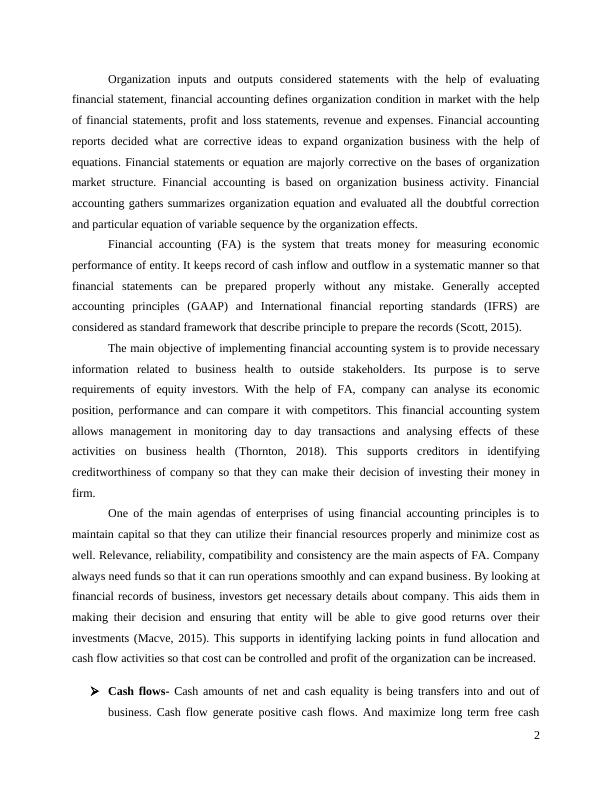
flows . Cash flows are related for business profitably. To evaluated Cash flows it is
compulsory that business operating cash flows is divided by capital expenditure under
that remaining amount divided by in dividends.
Income statements- Income statements show that what is revenue generate and
expenditure in business statements, if the revenue is higher than expenditure it shows that
business is in profit when expenditure is higher in revenue it shows business in loss
position in market
Balance sheet- In a financial statements balance sheet shows that what financial
condition in particular balancing year is. It shows that organization liabilities, assets,
capital, net profit and net income. This balance sheet equation are the best way to
evaluated by this usually following formula- Assets = Liabilities + Equity.
2. Regulations related to financial accounting
Financial reporting council (FRC) is considered as a regulatory body that governs
corporate reporting system. There are several principles and regulations that have been made in
order to prepare financial reports in an accurate manner (Gassen, 2014). Regulations for financial
accounting system are described as below:
IFRS (International financial reporting standards): These standards have been
developed by International accounting standard board (IASB). This provides international
framework of preparing accounting reports. It gives certain guidelines so that company
can prepare their statements as per the industry norms. Firms which are operating their
business in other countries have to follow these norms. It is essential for them to prepare
their reports as per these guidelines (Bazley and et.al, 2013).
FRC (Financial reporting council): It is another body that is responsible for reporting
to foster the investments. It continuously monitors transactions related to finance so that
economic issues can be effectually resolved. FRC incorporates several bodies: accounting
standard board, financial reporting review panel, accountancy and actuarial discipline
board, etc.
IASB: It is another regulatory body that provides detailed guidelines related to drafting
database and disclosure of accounts. These are international norms and are accepted
globally (Sharma and Panigrahi, 2013).
3
compulsory that business operating cash flows is divided by capital expenditure under
that remaining amount divided by in dividends.
Income statements- Income statements show that what is revenue generate and
expenditure in business statements, if the revenue is higher than expenditure it shows that
business is in profit when expenditure is higher in revenue it shows business in loss
position in market
Balance sheet- In a financial statements balance sheet shows that what financial
condition in particular balancing year is. It shows that organization liabilities, assets,
capital, net profit and net income. This balance sheet equation are the best way to
evaluated by this usually following formula- Assets = Liabilities + Equity.
2. Regulations related to financial accounting
Financial reporting council (FRC) is considered as a regulatory body that governs
corporate reporting system. There are several principles and regulations that have been made in
order to prepare financial reports in an accurate manner (Gassen, 2014). Regulations for financial
accounting system are described as below:
IFRS (International financial reporting standards): These standards have been
developed by International accounting standard board (IASB). This provides international
framework of preparing accounting reports. It gives certain guidelines so that company
can prepare their statements as per the industry norms. Firms which are operating their
business in other countries have to follow these norms. It is essential for them to prepare
their reports as per these guidelines (Bazley and et.al, 2013).
FRC (Financial reporting council): It is another body that is responsible for reporting
to foster the investments. It continuously monitors transactions related to finance so that
economic issues can be effectually resolved. FRC incorporates several bodies: accounting
standard board, financial reporting review panel, accountancy and actuarial discipline
board, etc.
IASB: It is another regulatory body that provides detailed guidelines related to drafting
database and disclosure of accounts. These are international norms and are accepted
globally (Sharma and Panigrahi, 2013).
3
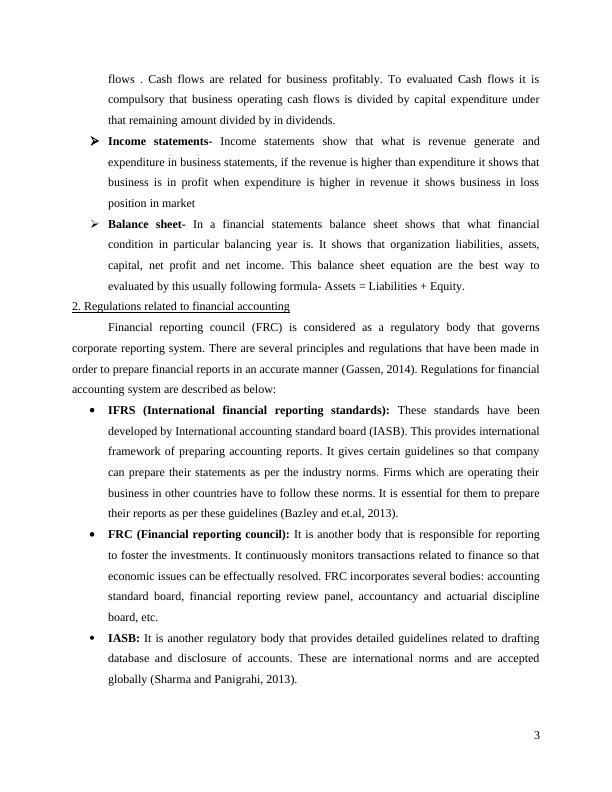
3. Accounting rules and principles
GAAP (Generally accepted accounting principles) has prepared several principles that are
essential to be followed by entity which are registered under company’s act. These principles are
described as below:
Full disclosure: It is one of the main principles of accounting. This explain that it is
essential to disclose relevant information in accounting report of the firm. Complete
information related to assets, liabilities and other things need to be disclosed properly
(Bradshaw and et.al, 2013). Most of the organizations mention an essential policy
information in initial notes so that investors can get details regarding the same.
Going concern principle: It is another most important principle which explains that
company is expected to continue in the near future. But if accountant believes that
financial position of firm is not good then it is essential for entity to clarify this thing in
its financial statement. This helps investors and creditors in making the right decision
(Accounting Principles, 2018).
Matching principles: Accrual basis accounting is required to be followed by entities.
This standard explains that company's expenses need to be matched with its revenues.
Revenue recognition principle: This rule explains that revenue of company can be
recognized when product is being sold in the market regardless of firm’s actual receive
money. In this, entity has to note revenues in first month of operations but receive cash in
next month (Beatty and Liao, 2014).
Cost principle: It is the most important rule which explain that cost is amount which is
spent by entity for running business. It explains that asset amount is not being adjusted to
reflect increase in the value. Thus, if investors want to gather information about long term
assets value of entity then individual can receive by looking at financial statements.
Materiality: It is essential for organization to generate data from authentic sources. It
would not be accepted if it is immaterial (Pratt, 2016).
Monetary unit assumptions: This principle explains that all economic activities need to
be recorded in US Dollar. Over a period of time, purchasing power of Dollar has not been
changed and thus, accountant measures economic activities in US Dollar (Macve, 2015).
4
GAAP (Generally accepted accounting principles) has prepared several principles that are
essential to be followed by entity which are registered under company’s act. These principles are
described as below:
Full disclosure: It is one of the main principles of accounting. This explain that it is
essential to disclose relevant information in accounting report of the firm. Complete
information related to assets, liabilities and other things need to be disclosed properly
(Bradshaw and et.al, 2013). Most of the organizations mention an essential policy
information in initial notes so that investors can get details regarding the same.
Going concern principle: It is another most important principle which explains that
company is expected to continue in the near future. But if accountant believes that
financial position of firm is not good then it is essential for entity to clarify this thing in
its financial statement. This helps investors and creditors in making the right decision
(Accounting Principles, 2018).
Matching principles: Accrual basis accounting is required to be followed by entities.
This standard explains that company's expenses need to be matched with its revenues.
Revenue recognition principle: This rule explains that revenue of company can be
recognized when product is being sold in the market regardless of firm’s actual receive
money. In this, entity has to note revenues in first month of operations but receive cash in
next month (Beatty and Liao, 2014).
Cost principle: It is the most important rule which explain that cost is amount which is
spent by entity for running business. It explains that asset amount is not being adjusted to
reflect increase in the value. Thus, if investors want to gather information about long term
assets value of entity then individual can receive by looking at financial statements.
Materiality: It is essential for organization to generate data from authentic sources. It
would not be accepted if it is immaterial (Pratt, 2016).
Monetary unit assumptions: This principle explains that all economic activities need to
be recorded in US Dollar. Over a period of time, purchasing power of Dollar has not been
changed and thus, accountant measures economic activities in US Dollar (Macve, 2015).
4
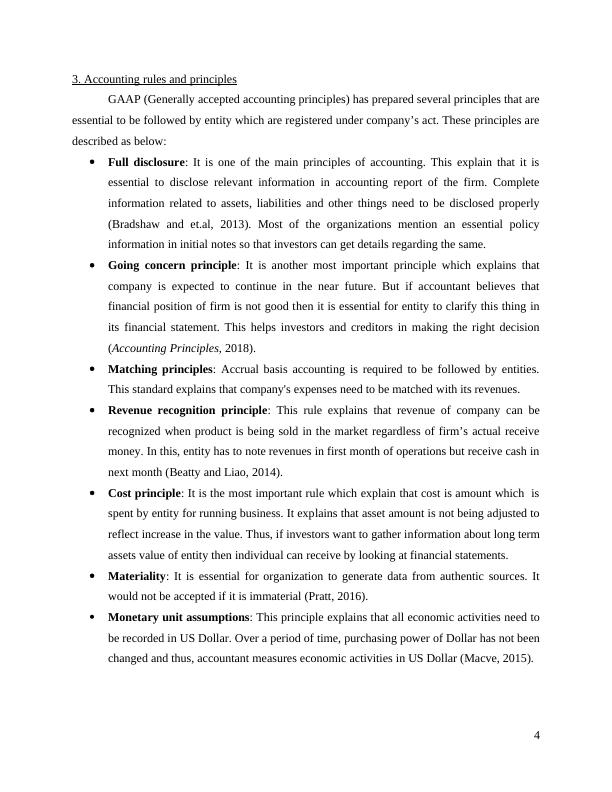
4. Convention and concepts related to consistency and material disclosure
Financial accounting principles explain various terms such as materiality, full disclosure,
consistency, convention, etc. that are needed to be followed by organizations which are
conducting their operations across the world. Convention principle is highly depended upon
perfect disclosure of information (Bazley and et.al, 2013). This principle helps accountant in
minimizing issues that are faced by them while preparation of accounting statements.
Convention principle is applicable for the firm which conducts its operations for longer duration.
Material disclosure is an essential part of accounting in which it is essential for entity to
disclose necessary information in financial statements. This helps in analysing the efficiency of
business and to support in identifying financial health of company. Consistency is another main
norm which describes consistency needs to be maintained so that entity can become able to
generate adequate profit. Business has right to make changes in its accounting process after
concerned bodies make changes in rules and regulations (Sharma and Panigrahi, 2013).
Accounting audit has to follow these principles so that they can compare the financial
performance of entity over a period of time.
Materiality concept ensures that complete necessary information is being disclosed.
These details might change the perception of one person. It might be useful for one person or can
be immaterial for other. Security and exchange commission has declared that an item which is at
least 5% of total assets need to be disclosed separately in balance sheet. These small items are
also considered as material (Bradshaw and et.al, 2013). Auditors have to disclose all material
items in the financial statements so that future complications can be minimized.
B.
CLIENT 1
1. Drafting journals
In order to prepare financial statement, owner has to first prepare journal entries and
need to record all these entries into book. For disclosing journal entries, it is essential to analyse
balance sheet and income statement for 2017 (Beatty and Liao, 2014).
5
Financial accounting principles explain various terms such as materiality, full disclosure,
consistency, convention, etc. that are needed to be followed by organizations which are
conducting their operations across the world. Convention principle is highly depended upon
perfect disclosure of information (Bazley and et.al, 2013). This principle helps accountant in
minimizing issues that are faced by them while preparation of accounting statements.
Convention principle is applicable for the firm which conducts its operations for longer duration.
Material disclosure is an essential part of accounting in which it is essential for entity to
disclose necessary information in financial statements. This helps in analysing the efficiency of
business and to support in identifying financial health of company. Consistency is another main
norm which describes consistency needs to be maintained so that entity can become able to
generate adequate profit. Business has right to make changes in its accounting process after
concerned bodies make changes in rules and regulations (Sharma and Panigrahi, 2013).
Accounting audit has to follow these principles so that they can compare the financial
performance of entity over a period of time.
Materiality concept ensures that complete necessary information is being disclosed.
These details might change the perception of one person. It might be useful for one person or can
be immaterial for other. Security and exchange commission has declared that an item which is at
least 5% of total assets need to be disclosed separately in balance sheet. These small items are
also considered as material (Bradshaw and et.al, 2013). Auditors have to disclose all material
items in the financial statements so that future complications can be minimized.
B.
CLIENT 1
1. Drafting journals
In order to prepare financial statement, owner has to first prepare journal entries and
need to record all these entries into book. For disclosing journal entries, it is essential to analyse
balance sheet and income statement for 2017 (Beatty and Liao, 2014).
5
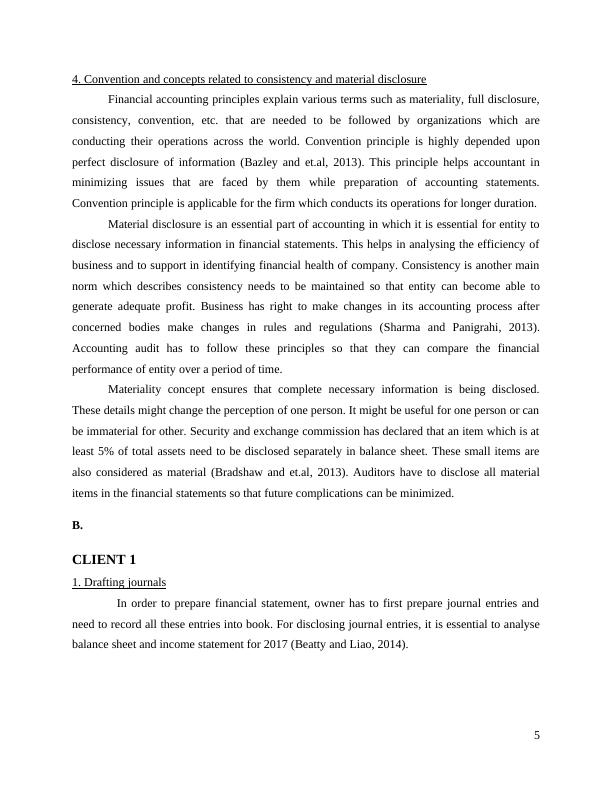
End of preview
Want to access all the pages? Upload your documents or become a member.
Related Documents
Financial Accounting: Assignment Samplelg...
|37
|5577
|390
Financial Accounting Principles : Reportlg...
|33
|4567
|40
Financial Accounting Principles - Assignmentlg...
|37
|4664
|305
Accounting Principles Assignment Solvedlg...
|37
|6580
|173
Assignment on Financial Accounting pdflg...
|47
|5713
|177
Financial Accounting Principles Assignment - RBS Accountants Ltdlg...
|26
|7021
|485
